转:locality sensitive hashing

Motivation
The task of finding nearest neighbours is very common. You can think of applications like finding duplicate or similar documents, audio/video search. Although using brute force to check for all possible combinations will give you the exact nearest neighbour but it’s not scalable at all. Approximate algorithms to accomplish this task has been an area of active research. Although these algorithms don’t guarantee to give you the exact answer, more often than not they’ll be provide a good approximation. These algorithms are faster and scalable.
Locality sensitive hashing (LSH) is one such algorithm. LSH has many applications, including:

- Near-duplicate detection: LSH is commonly used to deduplicate large quantities of documents, webpages, and other files.
- Genome-wide association study: Biologists often use LSH to identify similar gene expressions in genome databases.
- Large-scale image search: Google used LSH along with PageRank to build their image search technology VisualRank.
- Audio/video fingerprinting: In multimedia technologies, LSH is widely used as a fingerprinting technique A/V data.
In this blog, we’ll try to understand the workings of this algorithm.
General Idea
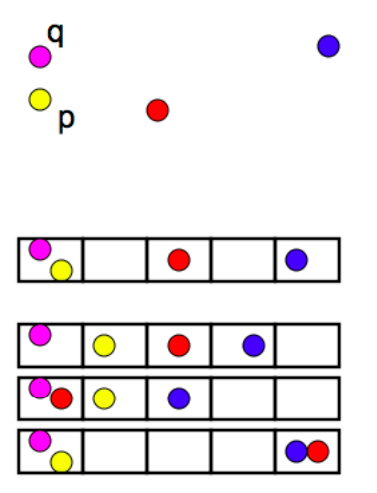
LSH refers to a family of functions (known as LSH families) to hash data points into buckets so that data points near each other are located in the same buckets with high probability, while data points far from each other are likely to be in different buckets. This makes it easier to identify observations with various degrees of similarity.
Finding similar documents
Let’s try to understand how we can leverage LSH in solving an actual problem. The problem that we’re trying to solve:
Goal: You have been given a large collections of documents. You want to find “near duplicate” pairs.
In the context of this problem//////再次问题的背景下, we can break down the LSH algorithm into 3 broad steps:
- Shingling
- Min hashing
- Locality-sensitive hashing
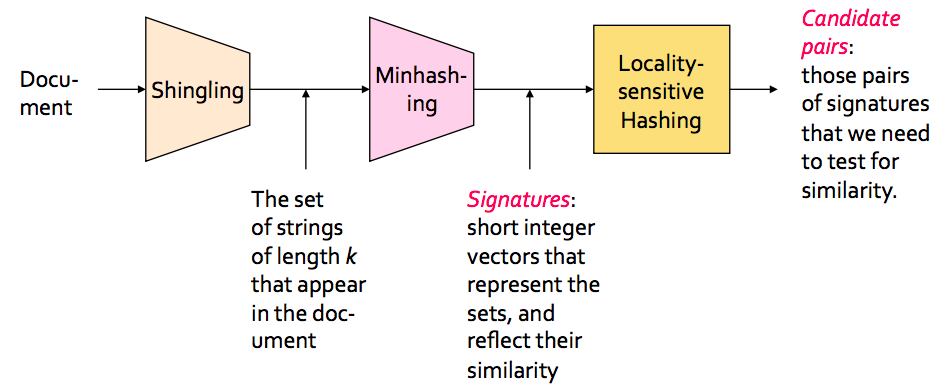
Shingling
In this step, we convert each document into a set of characters of length k (also known as k-shingles or k-grams). The key idea is to represent each document in our collection as a set of k-shingles.
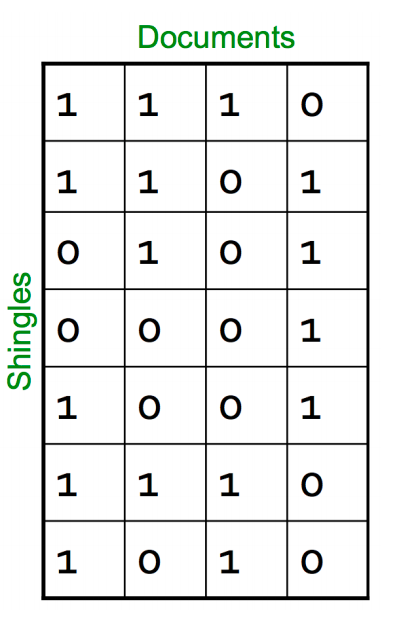
For ex: One of your document (D): “Nadal”. Now if we’re interested in 2-shingles, then our set: {Na, ad, da, al}. Similarly set of 3-shingles: {Nad, ada, dal}.
- Similar documents are more likely to share more shingles
- Reordering paragraphs in a document of changing words doesn’t have much affect on shingles
- k value of 8–10 is generally used in practice. A small value will result in many shingles which are present in most of the documents (bad for differentiating documents)
Jaccard Index
We’ve a representation of each document in the form of shingles. Now, we need a metric to measure similarity between documents. Jaccard Index is a good choice for this. Jaccard Index between document A & B can be defined as:
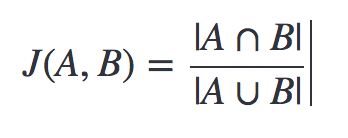
It’s also known as intersection over union (IOU).
A: {Na, ad, da, al} and B: {Na, ad, di, ia}.
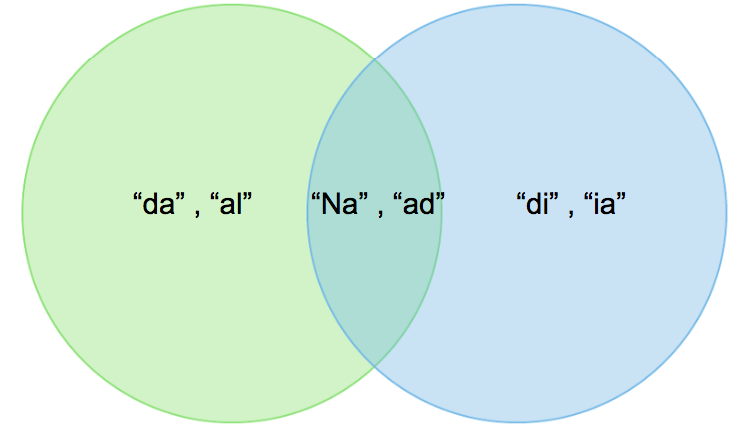
Jaccard Index = 2/6
Let’s discuss 2 big issues that we need to tackle:
Time complexity
Now you may be thinking that we can stop here. But if you think about the scalability, doing just this won’t work. For a collection of n documents, you need to do n*(n-1)/2 comparison, basically O(n²). Imagine you have 1 million documents, then the number of comparison will be 5*10¹¹ (not scalable at all!).
Space complexity
The document matrix is a sparse matrix and storing it as it is will be a big memory overhead. One way to solve this is hashing.
Hashing
The idea of hashing is to convert each document to a small signature using a hashing function H*.* Suppose a document in our corpus is denoted by d. Then:
- H(d) is the signature and it’s small enough to fit in memory
- If similarity(d1,d2) is high then *Probability(H(d1)==H(d2))* is high
- If similarity(d1,d2) is low then *Probability(H(d1)==H(d2))* is low
Choice of hashing function is tightly linked to the similarity metric we’re using. For Jaccard similarity the appropriate hashing function is min-hashing.
Min hashing
This is the critical and the most magical aspect of this algorithm so pay attention:
Step 1: Random permutation (π) of row index of document shingle matrix.

////////对行进行随机排列
Step 2: Hash function is the index of the first (in the permuted order) row in which column C has value 1. Do this several time (use different permutations) to create signature of a column.
第2步:哈希函数是列C值为1的第一行(按顺序排列)的索引。这样做几次(使用不同的排列)来创建一个列的签名。

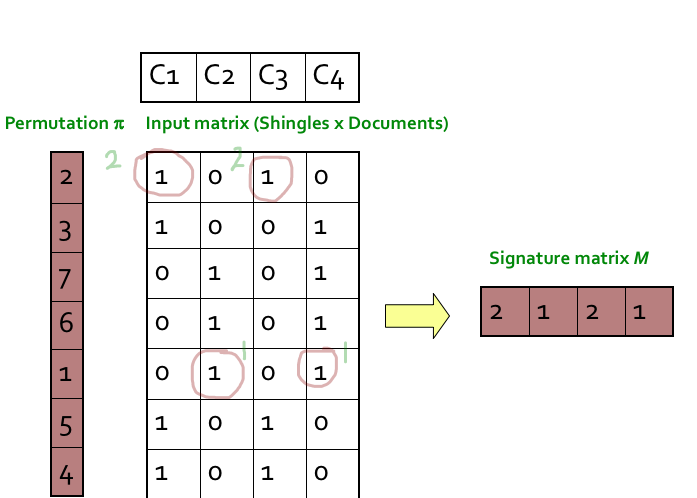
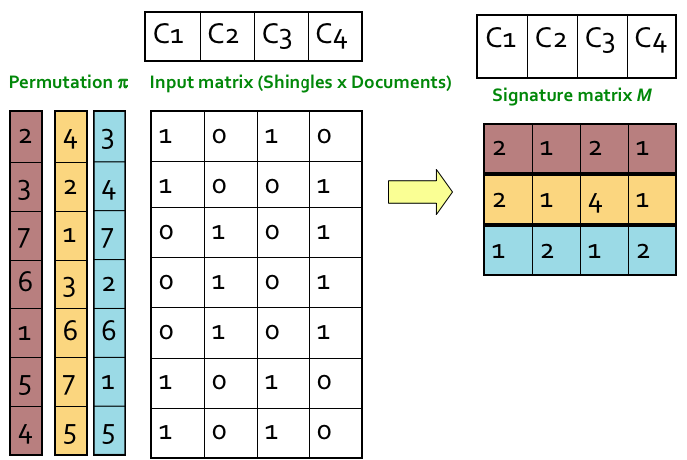
////这个图根本看不懂
转:locality sensitive hashing的更多相关文章
- [Algorithm] 局部敏感哈希算法(Locality Sensitive Hashing)
局部敏感哈希(Locality Sensitive Hashing,LSH)算法是我在前一段时间找工作时接触到的一种衡量文本相似度的算法.局部敏感哈希是近似最近邻搜索算法中最流行的一种,它有坚实的理论 ...
- 局部敏感哈希-Locality Sensitive Hashing
局部敏感哈希 转载请注明http://blog.csdn.net/stdcoutzyx/article/details/44456679 在检索技术中,索引一直须要研究的核心技术.当下,索引技术主要分 ...
- LSH(Locality Sensitive Hashing)原理与实现
原文地址:https://blog.csdn.net/guoziqing506/article/details/53019049 LSH(Locality Sensitive Hashing)翻译成中 ...
- Locality Sensitive Hashing,LSH
1. 基本思想 局部敏感(Locality Senstitive):即空间中距离较近的点映射后发生冲突的概率高,空间中距离较远的点映射后发生冲突的概率低. 局部敏感哈希的基本思想类似于一种空间域转换思 ...
- 局部敏感哈希算法(Locality Sensitive Hashing)
from:https://www.cnblogs.com/maybe2030/p/4953039.html 阅读目录 1. 基本思想 2. 局部敏感哈希LSH 3. 文档相似度计算 局部敏感哈希(Lo ...
- 局部敏感哈希Locality Sensitive Hashing(LSH)之随机投影法
1. 概述 LSH是由文献[1]提出的一种用于高效求解最近邻搜索问题的Hash算法.LSH算法的基本思想是利用一个hash函数把集合中的元素映射成hash值,使得相似度越高的元素hash值相等的概率也 ...
- 局部敏感哈希-Locality Sensitivity Hashing
一. 近邻搜索 从这里开始我将会对LSH进行一番长篇大论.因为这只是一篇博文,并不是论文.我觉得一篇好的博文是尽可能让人看懂,它对语言的要求并没有像论文那么严格,因此它可以有更强的表现力. 局部敏感哈 ...
- 从NLP任务中文本向量的降维问题,引出LSH(Locality Sensitive Hash 局部敏感哈希)算法及其思想的讨论
1. 引言 - 近似近邻搜索被提出所在的时代背景和挑战 0x1:从NN(Neighbor Search)说起 ANN的前身技术是NN(Neighbor Search),简单地说,最近邻检索就是根据数据 ...
- Locality Sensitive Hash 局部敏感哈希
Locality Sensitive Hash是一种常见的用于处理高维向量的索引办法.与其它基于Tree的数据结构,诸如KD-Tree.SR-Tree相比,它较好地克服了Curse of Dimens ...
随机推荐
- 使用GitHub API上传文件及GitHub做图床
本文介绍GitHub API基础及上传文件到仓库API,并应用API将GitHub作为图床 GitHub API官方页面 GitHub API版本 当前版本为v3,官方推荐在请求头中显示添加版本标识. ...
- uboot——初始化阶段
start.S |-------------设置cpu状态 |--------------开cache |--------------获得启动方式 |------------------------- ...
- JavaScript高级程序设计(第四版) -- 随笔 -- 数组(未完)
数组方法 .every() 与 .some() 传给两个个方法的函数都接收3个参数:数组元素.元素索引和数组本身. .every() -- 对于每一项都需要返回true,它才会返回true 若中途有一 ...
- Python_爬虫项目
1.爬虫--智联招聘信息搜集 原文链接 1 #-*- coding: utf-8 -*- 2 import re 3 import csv 4 import requests 5 from tq ...
- netcore一键部署到linux服务器以服务方式后台运行
@font-face { font-family: octicons-link; src: url("data:font/woff;charset=utf-8;base64,d09GRgAB ...
- ServiceStack.Redis 的 ASP.NET Core 扩展库
给大家安利一款 ServiceStack.Redis 的 ASP.NET Core 扩展库,它是基于 ServiceStack.Redis.Core 开发的. 简单易用,开源免费,使用ASP.NET ...
- JVM简单入门
目录 初识JVM 双亲委派机制 沙箱安全机制 Native PC计数器 方法区 栈 堆 工具分析OOM GC算法 GC算法总结 JMM 初识JVM JVM的位置:jre中包含jvm. 双亲委派机制 双 ...
- 正则表达式——maltrail工程项目中使用
1. 正则表达所需语法 \ 正则表达式使用反斜杠字符 ('') 来表示特殊形式或是允许在使用特殊字符时不引发它们的特殊含义. 转义特殊字符(允许你匹配 '*', '?', 或者此类其他) \A 只匹配 ...
- ABBYY FineReader 15新增智能PDF文档转换功能
ABBYY FineReader 15(Windows系统)新增智能PDF文档转换功能,可自动检测导入PDF数字文档的文本层质量,确保转变为可编辑格式后的准确结果:从表单字段和文本框中提取文本,准确保 ...
- 使用pdfFactory隐藏文档中的隐私信息
分享PDF文档时,文档中可能会存在一些隐私信息,比如用户名.用户的邮件地址.电话号码等信息.为了更好地保护原有文档内容的完整性,大家可以在生成PDF时,使用pdfFactory的隐藏信息功能,删除或遮 ...
